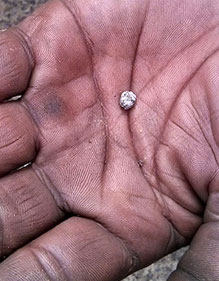|
Getting your Trinity Audio player ready...
|
 This article, first published on Bloomberg and written by journalist Kevin Crowley, investigates the illegal mining trade which is prevalent in South Africa.
This article, first published on Bloomberg and written by journalist Kevin Crowley, investigates the illegal mining trade which is prevalent in South Africa.
Corruption, and the poverty that's often a driver of corruption, plays a significant role in the continuation of this illicit industrial activity, and it involves the miners themselves, employees of active mines, metal dealers and syndicates in makeshift refining, money-laundering, and outright theft. The lack of prosecutorial action against perpetrators has also led to an illegal mining boom.
Hein Westraadt, a security manager at South Africa’s largest gold producer, was finishing up some paperwork when a colleague rushed to his desk with a tip-off.
Thirty-three illegal miners had smuggled themselves into one of Sibanye Gold’s biggest mines, and had been stealing ore undetected for three months, while living nearly two kilometres underground.
Westraadt’s discovery is a window into South Africa’s illegal precious-metals trade, worth as much as $1.3-billion a year, spanning poor immigrants, mine employees, metal dealers, makeshift refineries and criminal gangs. The concoction of corruption and poverty that encourages men to mine illegally is spreading the problem from abandoned mines to working ones, threatening the operations of a 120-year-old industry that has produced a third of all the world’s gold.
“It’s a huge problem across South Africa,” said Graham Briggs, CEO of Harmony Gold Mining, which shut Kusasalethu, its biggest operation, for two weeks in October after it was invaded by more than 100 alleged illegal miners. “There’s certainly more aggression and it’s more competitive. Any number of illegal miners can be a threat to your organisation, especially from a safety perspective.”
At dawn the morning after he made the discovery in March 2013, ex-policeman Westraadt, 51, assembled a team of 30 security guards and made the 40-minute journey in cage lifts and underground trains to level 43 in Kloof mine, 1.7 km deep into the earth.
Faeces found
They crawled through disused tunnels on their hands and knees in 38 degree-Celsius heat, and eventually found a mined-out section filled with plastic bottles, food wrapping and faeces.
After backing the thieves into a corner, they arrested the 33 men, who appeared to have been living there for about three months, and took them to police on the surface, Westraadt said. Their skin had lightened to a grey-like colour and the sunlight hurt their eyes after so long underground, he said.
“They’re not satisfied with abandoned mines anymore, they’re targeting working mines with richer ore,” he said. “This was by far our biggest bust, but they keep coming.”
The arrested men, all from the mountain kingdom of Lesotho, pleaded guilty to theft and were sentenced to between 20 months and eight years in prison, Sibanye said. Over the next three months, a further 66 people were arrested and subsequently pleaded or were found guilty of charges connected with illegal mining at Sibanye’s operations, according to the company.
Card rental
Illegal miners can rent employees’ access cards for as much as R20 000 ($1 700) a time to gain entry to mines, according to interviews with more than a dozen mining executives, security personnel, policemen and lawyers. Disguised as legal workers, they typically take the cage lift that lowers them down the shaft to the mining areas.
From there, in large mines such as Sibanye’s Kloof and Harmony’s Kusasalethu, which date back to 1939 and 1968 respectively, they can roam many hundreds of kilometres of access pathways, ventilation shafts, abandoned tunnels and operating areas.
During the day, employees drill holes in rock in which they place dynamite in the early afternoon. They vacate the mine while the rock is broken up by explosions. The illegal miners at Kloof hid in secluded areas during blasting and afterwards rushed down to gather ore before the night-shift workers entered, Westraadt said.
Amalgam balls
Gold is then separated out using mercury and water, just as Johannesburg’s first prospectors did in the 19th century. As a ton of ore typically yields only about five grams of gold in South Africa, illegal miners can smuggle the precious metal out of the mine in tiny balls about the size of a pea, known as amalgam.
The 33 men were found with about R30 000 worth of gold at the time of their arrest, according to court documents.
The illegal precious-metal trade, mainly in gold and platinum, costs the industry 5% to 10% of its annual production, or as much as R14.6-billion in 2012, according to South Africa’s Chamber of Mines. That’s excluding security expenses and the costs incurred in shutting down a mine such as Harmony’s Kusasalethu for two weeks.
Handwritten notes
After the arrests were made, Westraadt found at least a dozen headtorches, hundreds of batteries, and medicine bottles containing mercury, according to photographs provided by Sibanye. The pictures also show warehouse-sized boxes of tinned beans, strawberry- and banana-flavoured instant porridge, powdered milk, jars of peanut butter, toothpaste, and soap.
Handwritten notes to and from family members can also been seen in the images.
Food and drink is often smuggled in by mine employees, who can earn as much as R180 for a single tin, Westraadt said. Harmony disciplined 25 employees for aiding and abetting the 105 illegal miners who were arrested at its Kusasalethu mine in October, CEO Briggs said.
At one of the sentencing hearings for the 33 men guilty of theft at Sibanye, Judge Riaan de Bruin said it was “incomprehensible” how security systems could be bypassed so easily, making the company “partly to blame,” according to a transcript of the hearing on 24 June 2013.
Striking poverty
In mitigation, defence lawyer Frans Mphatswe said Sibanye suffered no financial loss because the men were stealing ore in abandoned areas, contrary to Westraadt’s account. He denied the prosecution’s claim that they resisted arrest and threw rocks at security guards.
“They are uneducated, your worship,” Mphatswe said. “They are unemployed, they are married. Your worship, they told me straight that poverty is striking them so, so hard.”
Mphatswe, who represented 13 of the men, said in a telephone interview that while the sentence was “harsh” given comparable cases, the judge was “fair and honest” in his summing up. He’s no longer in contact with the men, he said.
Melvin Ntimbane and Amanda Nel, who also worked for the defence, declined to comment and didn’t respond to multiple requests for comment respectively.
Criminal enterprise
Most of South Africa’s illegal miners are undocumented immigrants from neighbouring countries such as Lesotho, Mozambique and Zimbabwe, according to Paul Ramaloko, former spokesman for the Hawks, the South African police’s investigative unit. Those countries are some of the world’s poorest nations.
Judge De Bruin said the 33 men found at Sibanye were only the footsoldiers of a much bigger criminal enterprise. “What the accused did is only the first step of this whole operation, because this is organised crime,” he said, addressing the wider problem of illegal mining.
The Department of Mineral Resources is examining increasing punishments for illegal miners and for “those who send them down there,” Minister Ngoako Ramatlhodi said on 18 November. It also plans to seal more abandoned shafts with concrete to block access to both closed and operating areas, he said.
The police made “visible inroads” into the higher levels of criminal networks during 2014, Ramaloko said.
Money-laundering
One success was the sentencing of 10 members of a gang to serve a combined 115 years in prison for charges including trading unwrought gold and money-laundering, according to court documents.
Led by four brothers and operating from 1998 to 2008, the so-called Msimango gang was a “well-oiled syndicate” that reaped “lavish lifestyles” for its members, according to a transcript of the verdict delivered by Judge Johann Daffue in September.
The gang laundered the proceeds of its gold business through a trust, spent R5.1-million on houses and a further R2.2-million on cars, the judge said.
With the help of employees, gold ore was smuggled out of a Harmony processing plant in the Free State province and was purified in at least seven makeshift smelters on farms nearby, Daffue said. The gang moved to a new smelter each time it was interrupted by police. The case is unconnected to the theft of gold at Sibanye and the shutdown of Harmony’s Kusasalethu.
Rigged scales
The gang sold a portion of the processed gold to another syndicate in Gauteng province, Daffue said, citing evidence collected by police over almost a decade. Gauteng contains the commercial hub of Johannesburg and Pretoria, the capital. One of the gangs’ meeting points was Aloe Ridge Primary School, about 30 km south of Johannesburg.
On one occasion in 2004, one of the Msimango brothers, being chased by police, threw a black bin bag wrapped with brown tape containing R100 000 out of his car, according to the judgment. A rigged weighing scale, intended to defraud gold-ore suppliers, was also found.
The defendants, who pleaded not guilty at the outset of the trial, are preparing an appeal, according to their lawyer Johan Nel. He declined to comment further. Pieter Nel, who also represented the defendants, declined to comment.
While the case shows some success in prosecuting higher levels of the illegal precious-metals trade, the lack of action over the past five years has led to gold theft spiralling out of control, according to James Lorimer, a mining spokesman for the DA.
Clearly visible
“We have been saying this is a major problem for years but there has been a feeble reaction of the people at the top,” he said. “On the ground it appears to be getting worse.”
In September, Lorimer took a group of government officials and members of parliament on a trip around abandoned shafts near Roodepoort, 20 km west of Johannesburg, where South Africa’s gold was first discovered in 1884.
Following the same route with Bloomberg News a month later, illegal mining activities were clearly visible in full daylight.
A group of about 100 people could be seen processing gold using water and cloth on handmade tables, just yards from a main road near Roodepoort. A man who was part of the group and declined to be named, said they were mainly from Zimbabwe and Mozambique.
Dusty faces
Women with fisherman hats, babies tied on their backs with towels and long colourful skirts were on their knees bobbing up and down as they ground gold-bearing rock into a fine powder, ready for extracting gold, in concrete grooves on the ground.
Not far away, six young men could be seen walking to an abandoned shaft from a nearby township, with head lamps, kneepads and elbow pads. Two others, walking in the other direction, joked that they looked like white men because of the dust on their faces.
Tebogo Mokoena, 29, wearing a grey tracksuit top, yellow T-shirt and Adidas AG trainers, defended illegal mining as he lifted bags of gold-bearing rocks out of the shaft.
“I had to do this because there’s nothing else for me to do,” said Mokoena, who lost his job at dairy producer Parmalat four years ago. “There are no jobs. It’s our gold and they can’t stop us.”
Contact the reporter on this story: Kevin Crowley in Johannesburg at kcrowley1@bloomberg.net.









